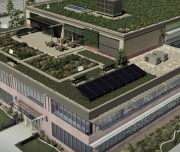Because planted roofs have a wide variety of benefits, roof replacement should be done with all other building systems in mind. The planted roof’s impact on the building’s heating and cooling loads should be taken into account to ensure that the HVAC system is not oversized. Captured rainwater may be integrated into the water system for certain uses, reducing the amount of potable water required.
System Bundling
System Bundling is a list of ideas for creating projects that combine high value activities to achieve efficiencies and cost savings. Bundling activities typically involve action at the intersection of two or more whole building systems such as Planted Roof and HVAC. System Bundling considers multiple related programs simultaneously, like optimizing energy efficiency and water efficiency.
Building systems and technologies work best when they work together, and your building can operate more efficiently and potentially cost less up front when considering the impact of systems on each other. Planted roofs have synergistic benefits that can result in energy savings and better management of stormwater; they provide insulation that may reduce the building’s heating and cooling loads and they filter and slow down stormwater runoff from the site. They are an attractive alternative to traditional roofing surfaces, potentially providing an amenity for occupants. When specifying or replacing a component of the planted roof system, consider bundling that component with others to deliver the largest beneficial impacts and greatest return on investment. For example, plants selected for the planted roof should require minimal supplemental water and irrigation systems designed for non-potable sources can reduce reliance on potable water. Leverage this section to understand whole building synergies and explore which technologies and components might best be bundled together.
Planted Roof and Hot Water
While reflective roofs, or “cool roof” systems, can save energy by reducing cooling loads, a planted roof can provide additional benefits, such as managing stormwater and providing greenspace and habitat. Plant selection should require no or minimal supplemental water. If supplemental water is required, consider alternative water sources for irrigation. While making changes to the roof, consider installing a solar thermal hot water system, which can yield significant energy savings. Save more on water heating costs by heating less water: high-efficiency plumbing fixtures, like low-flow showerheads, toilets and urinals, and high-efficiency faucets with sensor controls, save both energy and water. The reduced demand at the fixture paired with the free heat from the sun may enable the installation of a smaller boiler and pumps, saving on both first costs and operating costs.
Planted Roof and Energy Efficiency
In addition to providing insulation that may reduce the building’s heating and cooling loads, a planted roof can further improve the energy efficiency of the HVAC system in the summer if air intakes are placed around vegetated areas that have already lowered the ambient outdoor temperature. Ensure that reductions to the heating and cooling loads from the planted roof are considered in the design or upgrade of the HVAC system.
Solid Waste and Planted Roof
When adding a planted roof, consider the management of construction materials as well as the ongoing maintenance and management of planted roof materials. During construction, ensure there is adequate drainage to prevent erosion of the growing media from stormwater. In areas of the roof that are not adequately covered with vegetation and may be vulnerable to wind erosion, consider installing an erosion blanket or mat.
If the planted roof is accessible to occupants, provide recycling containers and waste receptacles and educate occupants about proper disposal to keep trash off the planted parts of the roof. Operations and maintenance personnel should be trained on the cleaning and maintenance procedure for planted roofs so as to minimize waste.

